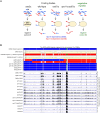DNA cytosine methyltransferases differentially regulate genome-wide hypermutation and interhomolog recombination in Trichoderma reesei meiosis
- PMID: 39021337
- PMCID: PMC11381340
- DOI: 10.1093/nar/gkae611
DNA cytosine methyltransferases differentially regulate genome-wide hypermutation and interhomolog recombination in Trichoderma reesei meiosis
Abstract
Trichoderma reesei is an economically important enzyme producer with several unique meiotic features. spo11, the initiator of meiotic double-strand breaks (DSBs) in most sexual eukaryotes, is dispensable for T. reesei meiosis. T. reesei lacks the meiosis-specific recombinase Dmc1. Rad51 and Sae2, the activator of the Mre11 endonuclease complex, promote DSB repair and chromosome synapsis in wild-type and spo11Δ meiosis. DNA methyltransferases (DNMTs) perform multiple tasks in meiosis. Three DNMT genes (rid1, dim2 and dimX) differentially regulate genome-wide cytosine methylation and C:G-to-T:A hypermutations in different chromosomal regions. We have identified two types of DSBs: type I DSBs require spo11 or rid1 for initiation, whereas type II DSBs do not rely on spo11 and rid1 for initiation. rid1 (but not dim2) is essential for Rad51-mediated DSB repair and normal meiosis. rid1 and rad51 exhibit a locus heterogeneity (LH) relationship, in which LH-associated proteins often regulate interconnectivity in protein interaction networks. This LH relationship can be suppressed by deleting dim2 in a haploid rid1Δ (but not rad51Δ) parental strain, indicating that dim2 and rid1 share a redundant function that acts earlier than rad51 during early meiosis. In conclusion, our studies provide the first evidence of the involvement of DNMTs during meiotic initiation and recombination.
© The Author(s) 2024. Published by Oxford University Press on behalf of Nucleic Acids Research.
Figures











Similar articles
-
Trichoderma reesei Rad51 tolerates mismatches in hybrid meiosis with diverse genome sequences.Proc Natl Acad Sci U S A. 2021 Feb 23;118(8):e2007192118. doi: 10.1073/pnas.2007192118. Proc Natl Acad Sci U S A. 2021. PMID: 33593897 Free PMC article.
-
Down-regulation of Rad51 activity during meiosis in yeast prevents competition with Dmc1 for repair of double-strand breaks.PLoS Genet. 2014 Jan;10(1):e1004005. doi: 10.1371/journal.pgen.1004005. Epub 2014 Jan 23. PLoS Genet. 2014. PMID: 24465215 Free PMC article.
-
Repair of exogenous DNA double-strand breaks promotes chromosome synapsis in SPO11-mutant mouse meiocytes, and is altered in the absence of HORMAD1.DNA Repair (Amst). 2018 Mar;63:25-38. doi: 10.1016/j.dnarep.2018.01.007. Epub 2018 Jan 31. DNA Repair (Amst). 2018. PMID: 29414051
-
Programmed induction of DNA double strand breaks during meiosis: setting up communication between DNA and the chromosome structure.Curr Opin Genet Dev. 2013 Apr;23(2):147-55. doi: 10.1016/j.gde.2012.12.002. Epub 2013 Jan 11. Curr Opin Genet Dev. 2013. PMID: 23313097 Review.
-
Repair of DNA double-strand breaks in plant meiosis: role of eukaryotic RecA recombinases and their modulators.Plant Reprod. 2023 Mar;36(1):17-41. doi: 10.1007/s00497-022-00443-6. Epub 2022 Jun 1. Plant Reprod. 2023. PMID: 35641832 Review.
Cited by
-
LCAT in Cancer Biology: Embracing Epigenetic Regulation, Immune Interactions, and Therapeutic Implications.Int J Mol Sci. 2025 Feb 10;26(4):1453. doi: 10.3390/ijms26041453. Int J Mol Sci. 2025. PMID: 40003919 Free PMC article. Review.
-
Cross-Kingdom DNA Methylation Dynamics: Comparative Mechanisms of 5mC/6mA Regulation and Their Implications in Epigenetic Disorders.Biology (Basel). 2025 Apr 24;14(5):461. doi: 10.3390/biology14050461. Biology (Basel). 2025. PMID: 40427651 Free PMC article. Review.
References
-
- Lyko F. The DNA methyltransferase family: a versatile toolkit for epigenetic regulation. Nat. Rev. Genet. 2018; 19:81–92. - PubMed
-
- Keeney S., Giroux C.N., Kleckner N.. Meiosis-specific DNA double-strand breaks are catalyzed by Spo11, a member of a widely conserved protein family. Cell. 1997; 88:375–384. - PubMed
MeSH terms
Substances
Supplementary concepts
Grants and funding
LinkOut - more resources
Full Text Sources
Research Materials

